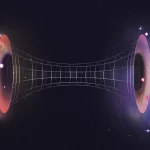Key Takeaways:
- Astronomers have detected light emanating from behind a black hole for the first time, confirming a key aspect of Einstein’s theory of general relativity.
- The discovery was made while studying X-rays emitted by a supermassive black hole in the galaxy Zwicky 1, located 800 million light-years away.
- These “luminous echoes” observed behind the black hole were unexpected and differed in size, timing, and color from the X-ray flares observed in front of the black hole.
- The phenomenon is explained by the warping of space-time around the black hole, allowing light to travel around it despite its gravitational pull.
- While not the first instance of observing gravitational lensing by black holes, this marks the first time light echoes have been observed from behind a black hole.
In a discovery, astronomers have unveiled the first-ever detection of light emerging from the rear of a black hole, a feat that not only illuminates the depths of our universe but also underscores the enduring relevance of Albert Einstein’s theories. This revelation, akin to peering through a cosmic veil, challenges conventional notions about black holes and their interaction with light.
The celestial spectacle unfolded as scientists delved into the enigmatic realm of a supermassive black hole entrenched within the heart of the spiral galaxy Zwicky 1, stationed a staggering 800 million light-years away. Amidst their scrutiny of the X-ray emissions emanating from this cosmic giant, researchers stumbled upon a peculiar phenomenon: luminous echoes originating from an unexpected source.
What set these luminous echoes apart was not merely their mysterious origin but also their distinct characteristics compared to the anticipated X-ray flashes emerging from the front of the black hole. These echoes, discernibly diminutive in size, temporally delayed, and displaying disparate hues, hinted at a cosmic conundrum begging for elucidation.
Upon meticulous analysis, scientists discerned the clandestine trajectory of these light echoes, tracing them back to their elusive source lurking behind the massive gravitational grasp of the black hole. This revelation, in harmony with Einstein’s venerable theory of general relativity, unveils the intricate interplay between space-time curvature and the propagation of light in the cosmic theater.
Dan Wilkins, a research scientist at the Kavli Institute for Particle Astrophysics and Cosmology at Stanford University, articulated the essence of this discovery, emphasizing the pivotal role of space-time warping in bending light and shaping our cosmic observations. The black hole’s gravitational grip, formidable though it may be, yields to the inherent curvature of space-time, granting astronomers a glimpse into the hidden recesses of the universe.
Einstein’s revolutionary insights into the nature of gravity, encapsulated within his theory of general relativity, offer a compelling framework for comprehending the gravitational ballet choreographed by celestial bodies. The curvature of space-time, a fundamental tenet of Einstein’s theory, dictates the trajectory of light and the dynamics of cosmic phenomena unfolding in the vicinity of massive objects like black holes.
While gravitational lensing, the phenomenon wherein light bends around massive objects, has been previously observed, the revelation of light echoes from behind a black hole marks an unprecedented milestone in astronomical observation. This serendipitous discovery, born of scientific curiosity rather than explicit intention, underscores the symbiotic relationship between empirical inquiry and cosmic revelation.
The quest to unravel the intricacies of black hole dynamics extends beyond the realm of theoretical conjecture, as scientists harness cutting-edge technology to probe the cosmic mysteries shrouded within these enigmatic entities. Leveraging the European Space Agency’s XMM-Newton and NASA’s NuSTAR space telescopes, researchers endeavor to decipher the intricate dance of light and gravity unfurling in the vicinity of black holes.
The luminous echoes emanating from behind the black hole offer a tantalizing glimpse into the inner workings of these cosmic behemoths, shedding light on the mechanisms underlying their enigmatic coronal emissions. The super-hot corona enveloping the black hole, a maelstrom of magnetized plasma and searing temperatures, serves as a crucible for the generation of intense X-ray emissions.
As researchers delve deeper into the cosmic tapestry woven around black holes, they are poised to unravel the mysteries of light propagation and coronal dynamics with unprecedented clarity. The publication of these groundbreaking findings in the esteemed journal Nature heralds a new chapter in our cosmic odyssey, beckoning us to explore the frontiers of space-time curvature and the luminous echoes that traverse its intricate contours.


